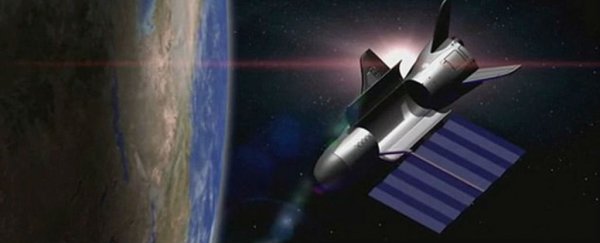On 20 May 2015, the US Air Force launched a solar-powered, unmanned space plane into Earth's orbit to carry out its fourth top secret mission, and now, almost two years later, we're still no closer to figuring out what it's doing up there.
The robotic X-37B space plane has now entered its 678th day in orbit, breaking its own record for the number of consecutive days spent in space, and the government remains tight-lipped on when it might be brought back down to Earth.
"The landing date will be determined based on the completion of the program's on-orbit demonstrations and objectives for this mission," Captain AnnMarie Annicelli, an Air Force spokeswoman, told Space.com.
Exactly what those mission objects are is anyone's guess, and there have been many in recent years - including spying on the Middle East, space bombing (which isn't even technically feasible), and keeping tabs on China's ill-fated space station.
The space-bomber theory has been more or less debunked, with former chief scientist of the US Air Force, Mark Lewis, telling Popular Science that the amount of thrust needed to keep changing its position in orbit would be tremendous.
Plus it wouldn't exactly be the most accurate space bomber ever deployed.
"If I can't get my alleged bomber to the right location to release its bomb, what good is it?" he said.
More likely, perhaps, are surveillance measures - a theory that has followed the space plane since 2010, when several amateur observers reported that it flew over the same region on the ground every four days soon after its initial launch.
And, as Popular Science pointed out more recently, the Air Force now has a second X-37B space plane, and a separate group of civilian satellite trackers noted that its orbit takes it over countries such as Iran, Afghanistan, and Pakistan.
Conflicting statements by government officials that seemed to both confirm and deny its offensive capabilities only encouraged public speculation in the early days.
"In interviews and statements, Pentagon leaders strongly denied that the winged plane had anything to do with space weapons, even while conceding that its ultimate goal was to aid terrestrial war fighters with a variety of ancillary missions," The New York Times reported in May 2010.
At the time, the Air Force responded by stating that the secret mission has "no offensive capabilities," but rather, "The program supports technology risk reduction, experimentation, and operational concept development."
 Boeing
Boeing
The mystery space plane, which looks just like a mini space shuttle, has embarked on four top secret orbital missions so far, and each time has broken its own record for the length of time in space.
Its previous record was 674 days, set during its last mission that spanned from December 2012 to October 2014.
According to Mike Wall at Space.com, the plane has only been designed to spend 270 days out in space, so it's now cleared its expected orbital lifespan twice, and the mission is now "the longest in the clandestine program's history".
Of course, it could be that the Air Force really is just conducting science up there, with Annicelli telling Wall that it's testing everything from navigation and thermal protection systems to autonomous orbital flight, re-entry, and landing techniques.
And hey, if we never find out what X-37B's mission actually is, at least it's showcasing the capabilities of prolonged solar-powered flight.
